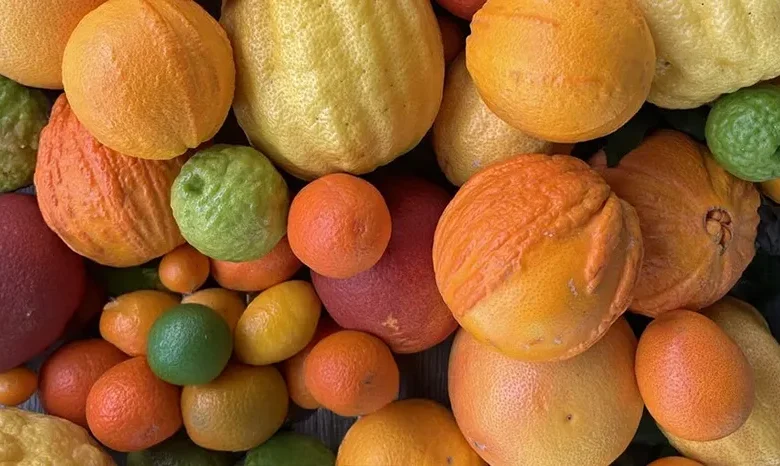Citrus Fruits from Dominica

Citrus fruits from Dominica are an integral part of Dominica’s agricultural heritage. The nation’s fertile volcanic soil, tropical climate, and abundant rainfall allow for cultivating a wide range of citrus varieties, including oranges, grapefruits, limes, lemons, and tangerines. Each contributes to the country’s economy, cuisine, and export market.
Types of Citrus Fruits Grown in Dominica
The Types of Citrus Fruits Grown in Dominica include a diverse range of oranges, grapefruits, limes, lemons, and tangerines, each thriving in the island’s rich, fertile soil and accommodating climate.
Oranges
Oranges are among the island’s most widely cultivated citrus fruits, thriving in the humid lowlands and mid-latitude regions. The dominant varieties include:
- Valencia Orange – Known for its sweet taste and high juice content, it is commonly used in fresh juice production.
- Blood Orange – Less common but valued for its deep red flesh and antioxidant properties.
- Seville Orange – A more acidic variety, primarily used for marmalades and culinary applications.
Grapefruits
Dominica produces pink and white grapefruit varieties, recognized for their large size and balance of sweet and tart flavours. These fruits are commonly eaten fresh, juiced, or used in desserts and preserves. Grapefruit farming in Dominica contributes to the local and regional export markets, with demand in neighbouring Caribbean nations.
Limes
Limes thrive throughout the island, particularly in coastal and low-lying areas. The two main varieties cultivated include:
- Key Lime (Mexican Lime) – Characterized by its small size, thin rind, and highly aromatic juice, essential in local cuisine and beverages.
- Persian Lime (Tahitian Lime) – A more extensive, seedless variety with a milder acidity, often used in commercial lime juice production.
Limes are widely used in Dominican cooking and medicinal remedies, cocktails, and marinades.
Lemons
Lemons are cultivated on a smaller scale but remain a vital citrus crop. The primary varieties include:
- Eureka Lemon – A bright yellow, high-acid fruit commonly used for culinary and medicinal purposes.
- Meyer Lemon – A sweeter hybrid variety used in desserts, beverages, and sauces.
Lemons from Dominica are typically grown organically, with farmers using natural pest control methods to maintain high-quality production.
Tangerines (Mandarins)
Tangerines, or mandarins, are grown in mid-altitude areas, offering a sweet and easy-to-peel citrus variety. The most popular types include:
- Dancy Tangerine – A deep orange, seedless variety with a sweet and tangy flavour.
- Clementine – A small, fragrant citrus fruit, often enjoyed fresh or used in fruit salads and confections.
Tangerines are widely consumed in Dominica and are a favourite among local farmers’ markets.
Culinary and Cultural Significance
Citrus fruits play a vital role in Dominican cuisine, where they are used for juices, marinades, sauces, and desserts. Traditional uses include:
- Freshly squeezed citrus juices for refreshment and vitamin C intake.
- Lime and lemon-based marinades for fish, meats, and poultry.
- Grapefruit and orange zest as key ingredients in cakes, jams, and preserves.
- Fermented citrus drinks are used in local herbal medicine and immune-boosting tonics.
Beyond food, citrus peels and extracts are also used in aromatherapy, natural cleaning agents, and skincare products.
Nutritional and Medicinal Benefits
Dominica’s citrus fruits are nutrient-dense and rich in antioxidants, offering various health benefits:
- Vitamin C – Boosts immune function and promotes skin health.
- Flavonoids – Found in citrus peels, aiding in anti-inflammatory and heart-protective benefits.
- Fibre – Supports digestive health and aids in weight management.
- Essential Oils – These are used in natural medicine and cosmetics for their antibacterial and soothing properties.
Locally, citrus-based remedies are widely used for treating colds, fevers, and digestive issues.
Seasonality and Availability
The harvesting seasons for citrus fruits in Dominica vary depending on the variety:
- Oranges and grapefruits – Peak season from November to April.
- Limes and lemons – Available year-round, with peak harvests from July to October.
- Tangerines – Primarily harvested during the cooler months (December to February).
The ability to grow citrus throughout the year ensures a steady supply for both local consumption and export markets.
Sustainability and Farming Practices
Most citrus farms in Dominica employ sustainable agricultural techniques, including:
- Organic and pesticide-free farming to maintain soil health and biodiversity.
- Agroforestry systems, where citrus trees are intercropped with banana, cocoa, and other fruit trees.
- Rainwater harvesting and drip irrigation to optimize water usage.
Government initiatives and agricultural cooperatives continue to support small-scale citrus farmers, ensuring that Dominica’s citrus industry remains resilient against climate change and market fluctuations.
Future Prospects for Citrus Farming in Dominica
The demand for organic and sustainably grown citrus is increasing in global markets, presenting opportunities for:
- Expansion of citrus exports to new markets in Europe and North America.
- Value-added citrus products, including citrus-based essential oils, juices, and organic fruit powders.
- Investment in modern farming technology to improve yields and climate resilience.
With ongoing support from government policies, research institutions, and trade organizations, Dominica’s citrus sector is well-positioned for long-term sustainability and economic growth.
Expanding the Reach of Dominica Citrus Fruits
Citrus Fruits from Dominica are a vital part of the island’s agricultural, culinary, and economic landscape. Each variety offers distinct flavours and nutritional benefits, from the sweet Valencia oranges to the aromatic Key limes. As the industry evolves, sustainable farming practices and market expansion will ensure Dominica remains a key player in Caribbean citrus production.




